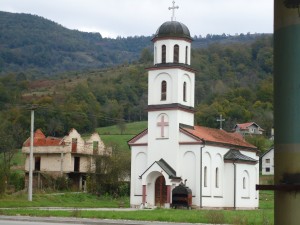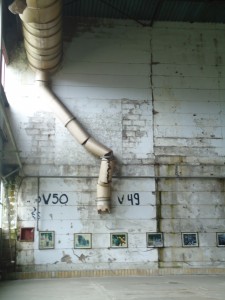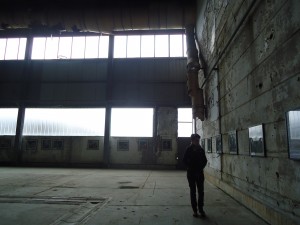How did I come to find myself alone in the remains of a battery factory with chips of the floor missing where bullets fell and the only sound that of turning pages in a book echoing around me?
I’m here because about six thousand refugees found themselves in the same place nearly a decade ago. They were victims of ethnic cleansing in eastern Bosnia seeking protection in and around the town of Srebrenica–an area that the UN declared a “safe zone” at the time. When refugees came to the factory, which had already been abandoned and re-inhabited by NATO forces, Dutch soldiers told them who could enter and who could not because there was not enough space for everyone escaping the Bosnian Serb army. Soon after, however, it didn’t matter who was granted their protection because General Ratko Mladić confronted the NATO forces with an ultimatum: they could step out of the way and survive, or they could die with the people huddled inside the factory.
Across the road from the factory is the Srebrenica genocide memorial and graveyard for victims of the massacre. It is estimated that more than 8,000 Bosniak men and boys were killed in less than a week in July 1995. Six thousand of their bodies have been found and 1,000 are currently waiting on the shelves of a facility in the city of Tuzla so that they can be identified before joining those which are already buried across from the factory. The other thousand are presumed to be in mass graves yet to be discovered.
On our way to the Srebrenica memorial we stopped at a gas station that is rumored to be built on top of a mass grave. Apparently, there is a monetary reward for locals who share any information they know regarding this rumor or the location of missing bodies. No one has spoken.
Across from the gas station is a small Orthodox church. Next to the church is a blasted, burned, and abandoned house. If the Bosniak family who lived there survived the war and came back, it would be clear to them who the town “belongs” to now. One woman did come back. Her entire family was killed, but she returned to her home–located just behind the church. She is petitioning to have the town move the church away from her property.
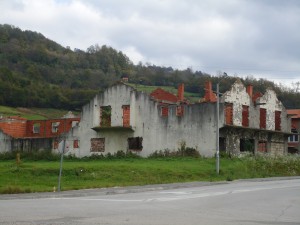
This seemingly godforsaken corner of Bosnia became infamous for the tragedy it witnessed. For the Clinton administration, it was a source of guilt–how could 8,000 civilians die in three days while the international community watched? The story goes that the Dutch commander stationed there sent a request for airstrikes to counter the Bosnian Serb army, but he submitted his request using the incorrect paperwork and was consequently ignored by the UN. Regardless of whether the mistake was so trivial, international diplomats have been trying to make up for it ever since. Claiming that we could not allow Srebrenica to happen ever again, the United States took responsibility for the rest of the conflict in Bosnia as well as the war in Kosovo. Srebrenica’s name continues to echo in assemblies when international organizations like the UN turn their attention towards potential genocides in other regions.
Some American journalists and politicians pat our country on the back, touting, “See? We like Muslims, we saved Muslims in Bosnia,” as if to redeem the War on Terror. Angelina Jolie was so moved by the genocide and other tragedies of the war in Bosnia that she directed a film set during the conflict and co-hosted a global conference this year addressing rape as a weapon of war.
But when I enter that factory across the road from the memorial, I can see that the international community is far more invested in displaying the dead bodies that justify intervention than it is in displaying the lives that existed before the war or the suffering that those bodies experienced before they were thrown into mass graves. I can see this because of the difference between the rows and rows of blinding white grave stones and the dim, icy building I enter.
The factory, now labeled “Srebrenica Genocide Memorial Room,” is lit only by natural light seeping through the windows and holes in the walls. The pictures hanging between graffiti and broken pipes are deteriorating. One of them is so damaged I can’t even see what it depicts, but like the rest of them, it is most likely a picture of refugees scouring for food in the trash NATO troops left behind or women and children mourning as they are taken from the safe haven and the men in their families as the Dutch soldiers surrender the factory. The small paper captions taped to the pictures are torn and curling from the moisture in the air. Consistent mistakes in spelling and grammar make it clear that someone from the local community took time to put this exhibit together, not a professional curator from the outside world. Awkwardly placed in the middle of the factory is a display of photographs of men who died in the Srebrenica massacre accompanied by personal belongings that were exhumed with their bodies. Marbles, a lighter, a watch, a pair of glasses…behind the glass protecting these objects there are cobwebs and mold.
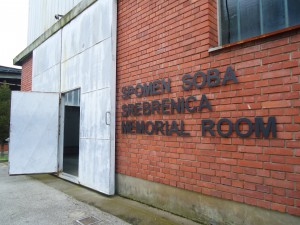
Further down the road is a room full of TVs playing footage from the war and trials at the International Tribunal for the former Yugoslavia (ICTY). Unlike the Memorial Room, this room is clean and its contents well-kept. Again, I wonder, why are the tributes to dead bodies and the men who decided their fate so carefully tended to while the memories of individuals, their lives, and those who survived growing mold and disintegrating? Are we commemorating tragedy to the point where we obsess over “cold-blooded hatred” and death rather than honoring the lives lost? The victims of Srebrenica are not numbers for the history books or white pillars standing in meticulous rows, even if that’s all we see left of them. That should not be all that we see left of them.
Our group returns to the factory to use the bathroom before leaving, and I decide to flip through the visitor’s book in the front entrance. Everyone else trickles out of the building while I stand there filtering through poems and prayers written in various languages. A prayer signed “from Palestine;” a signature from a group of Japanese students; half a page written in Arabic; but more than anything, written over and over in English and Bosnian: “never forget Srebrenica.” Someone wrote this and then added “never forgive.” I suddenly realize that the only sound I can hear is the swoosh of pages turning, cutting the cold silence. How strange it is to find myself reading a book alone in a battery factory tucked between the hills of eastern Bosnia. Why is such a thing possible?
